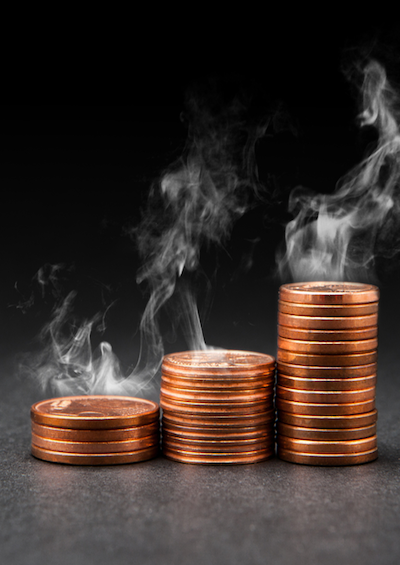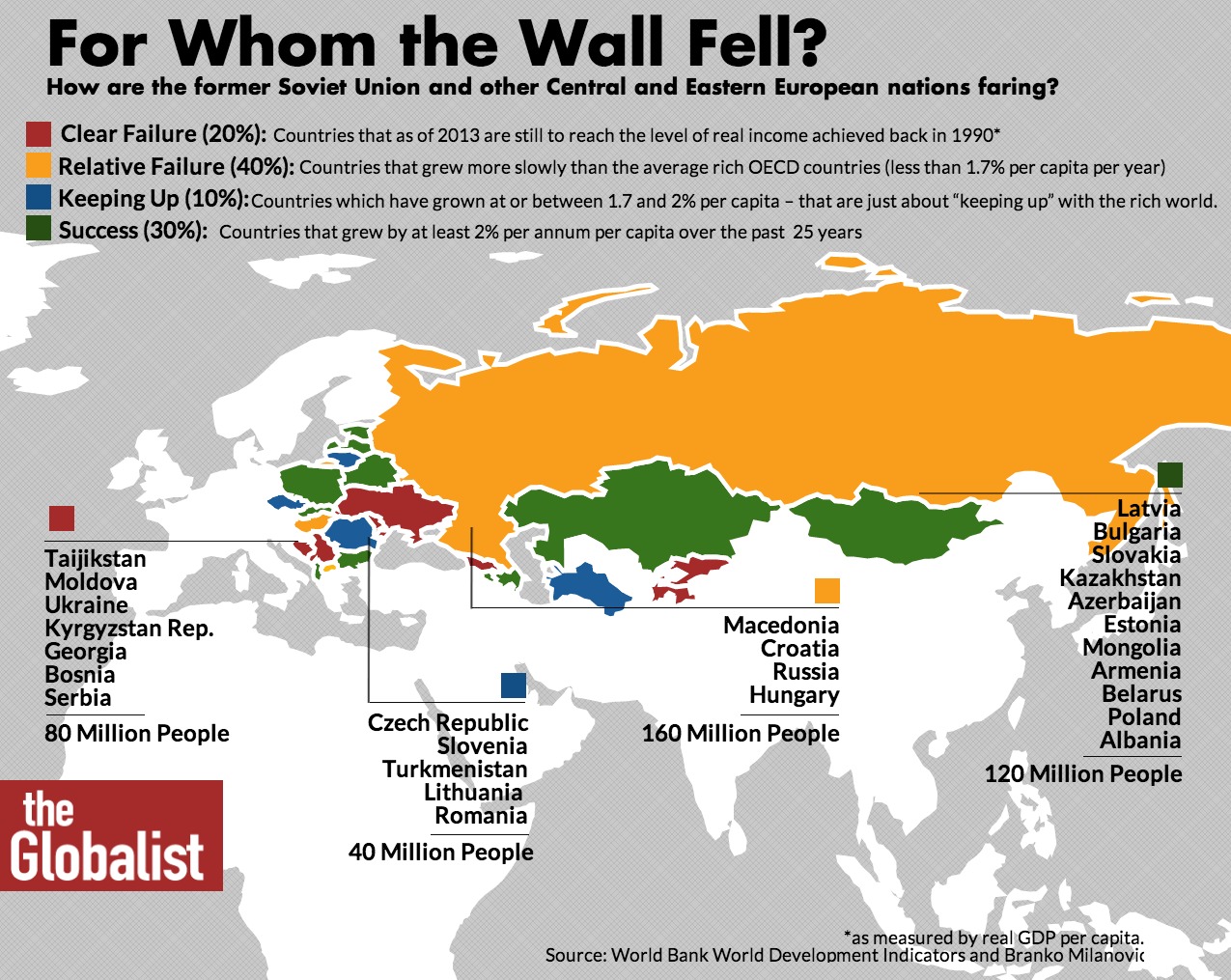For Whom the Wall Fell? A Balance Sheet of the Transition to Capitalism
Only 1 out of 10 people living in “transition” countries have seen a successful transition to capitalism and more democracy.
November 7, 2014

Twenty-five years after the fall of the Berlin Wall, what does the balance sheet of so-called “transition” countries (even if the term is no longer fully adequate) look like?
For me, that issue has dual personal relevance. First, I am originally from one of them (Serbia). And second, I worked on most of these countries in the 1990s at the World Bank.
I also discussed and documented the resulting Great Depression those countries experienced post-Communism in my 1998 book “Income, inequality and poverty during the transition to market economies.”
For clarity’s sake, and to asses their relative performance, let’s organize these countries into four distinct groups. What naturally comes to mind to an economist is to look first at how these countries have done in terms of economic growth.
Clear and relative failures vs. successes
“Clear failures” are those countries that as of 2013 are still to reach the level of real income achieved back in 1990 (as measured by real GDP per capita).
“Relative failures” are those countries that grew more slowly than the average rich OECD countries – that is at less than 1.7% per capita per year. They are so labeled because they are not converging to the rich countries’ income levels.
The third group consists of countries – having grown at between 1.7 and 2% per capita – that are just about “keeping up” with the rich world.
Finally, the “success cases” are countries that grew by at least 2% per annum per capita over the 25-year period since 1989.
Mind you, the requirement of growing by 2% per year over a quarter of a century is not particularly onerous, nor is such an achievement very stirring. A nation would need 35 years, almost two generations, of such growth to double its per capita income.
(All growth rates referred to here are expressed in per capita terms, derived from GDPs based on 2011 International Comparison Project PPP data, and downloadable from the World Bank World Development Indicators.)
How does the picture look? In the bottom group of “clear failures,” we have seven countries with a combined population of almost 80 million (20% of the population of all “transition” countries).
They are, in order of the extent of their failure: Tajikistan, Moldova, Ukraine, Kyrgyz Republic, Georgia, Bosnia and Serbia.
All except Ukraine (note that current data end in 2013) have been involved in civil or international conflicts. None is likely to reach its 1990 income any time soon.
Basically, they are countries with at least three to four wasted generations. At current rates of growth, it might take them some 50 or 60 years—longer that they were under Communism! — to get back to the income levels they had at the fall of Communism.
The “relative failures” include four countries (Macedonia, Croatia, Russia and Hungary). As a group, because of the large size of Russia, they comprise 160 million people and represent the largest of our four groups.
Some 40% of transition countries’ populations live there. Their growth rates have been less or around 1% per capita.
Relative and real successes
There are five countries in the region that are managing just “keeping up” with the rich capitalist world. They are the Czech Republic, Slovenia, Turkmenistan, Lithuania and Romania.
They include 40 million people (or 10% of transition countries’ total population). Their growth rates have been between 1.7 and 1.9% per capita annually.
Finally, we come to the “success cases,” those that are catching up with the rich world. There are 12 countries in this group.
In increasing order of success, they are: Uzbekistan and Latvia (average growth rate of 2%), Bulgaria (2.2%), Slovakia and Kazakhstan (2.4%), Azerbaijan, Estonia, Mongolia and Armenia (around 3%), Belarus (3.5%), Poland (3.7%) and Albania (3.9%). The population living there amounts to 120 million (almost a third of the total).
If we concentrate on success cases, several of them (Azerbaijan, Kazakhstan, Uzbekistan and Mongolia) are resource-rich economies whose success is entirely explained by the exploitation of hydrocarbons, gold or other minerals.
The real capitalist successes are only five: Albania, Poland, Belarus, Armenia and Estonia. They managed to grow by at least 3% per capita per annum, almost at twice the rate of rich countries, and without an obvious help of natural resources.
Armenia is particularly remarkable since its original period of transition was rocky, due to the war with Azerbaijan.
If in addition to growth, we broaden our gaze to income inequality, there are extremely high increases in some countries like Russia (which, with a rather sluggish overall growth, produced very modest decreases in poverty), the three Baltic countries and Georgia.
In all of them, inequality, measured by the Gini index, increased by more than 10 points, which is twice as much as it increased in the United States between mid-1980s and today.
On the other hand, central European countries registered rather small Gini increases and currently have stable low-to-moderate inequality levels, very much in line with the rest of OECD.
The data for Central Asian countries are not reliable, but they most likely underwent a significant increase in inequality.
Does capitalism advance democracy?
If we also require, as is widely assumed, that a successful transition to liberal capitalism – in addition to the catch-up with the rich world and rather moderate increase in inequality — should also imply progress toward democracy, what does the record show there?
If we go back to our list of five success cases, then two countries – Belarus and Armenia – drop out of the list on account of unconsolidated or inexistent democracy. In 2012, Belarus’s Polity Score for Democracy, on a scale from minus 10 to plus 10 was -7, and Armenia’s +5.
That leaves us with only three successes: Albania, Poland and Estonia. Albania had a somewhat less than exemplary transition to democracy, and it still may not be included in the list of fully consolidated democracies (although its current Polity Score for Democracy, like Estonia’s, is a high +9).
Data on pre-transition inequality are non-existent for Albania, so we really do not know how much inequality increased there.
Most people’s expectations on November 9, 1989, were that the newly established capitalism in Eastern Europe will result in economic convergence with the rest of Europe, moderate increase in inequality and consolidated democracy.
These hopes and expectations are fulfilled most likely in only one country (Poland) and, at the very most, in another two rather small countries (Estonia and Albania). Their total populations are 42 million, or some 10% of all former Communist countries.
Thus, one out of 10 people living in “transition” countries could be said to have “transitioned” to the capitalism that was promised by those who waxed alluringly about the triumph of liberal democracy and free markets.
In this short piece, obviously, I cannot go into political developments which were also much worse than expected, nor into wars that continue and have cost, conservatively estimated, 250,000 lives so far (based on Nicholas Sambanis’ database on ethnic conflict).
Nor can I reflect major declines in life expectancy in Russia and Ukraine, or the sluggish or negative population growth rates in most European former socialist countries, or pervasive corruption and kleptocracy.
Conclusion
So, what is the balance sheet of transition?
1. Only three or at most five or six countries could be said to be on the road to becoming a part of the rich and (relatively) stable capitalist world.
2. Many of the other countries are falling behind, and some are so far behind that they cannot aspire to go back to the point where they were when the Wall fell for several decades.
3. Despite philosophers of “universal harmonies” such as Francis Fukuyama, Timothy Garton Ash, Vaclav Havel, Bernard Henry Lévy and scores of international “economic advisors” to Boris Yeltsin, who all fantasized about democracy and prosperity, neither really arrived for most people in eastern Europe and the former Soviet Union.
The Wall fell only for some.
Takeaways
After a quarter century, what does a country-by-country balance sheet of the transition to capitalism reveal?
For all its resource riches, Russia has produced very modest decreases in poverty since 1990.
The high hopes of 1989 are fulfilled most likely in only one country, Poland.
The Wall only fell for some countries – despite the supposed triumph of liberal democracy and free markets.
Read previous

Global Economy
For Whom the Wall Fell?
November 7, 2014

